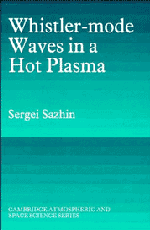Book contents
- Frontmatter
- Contents
- Acknowledgements
- Introduction
- 1 Basic equations
- 2 Propagation in a cold plasma
- 3 Parallel propagation (weakly relativistic approximation)
- 4 Parallel propagation (non-relativistic approximation)
- 5 Quasi-longitudinal approximation
- 6 Quasi-electrostatic approximation
- 7 Growth and damping of the waves
- 8 Non-linear effects
- 9 Applications to the Earth's magnetosphere
- References
- Solutions to the problems
- Index
Introduction
Published online by Cambridge University Press: 30 October 2009
- Frontmatter
- Contents
- Acknowledgements
- Introduction
- 1 Basic equations
- 2 Propagation in a cold plasma
- 3 Parallel propagation (weakly relativistic approximation)
- 4 Parallel propagation (non-relativistic approximation)
- 5 Quasi-longitudinal approximation
- 6 Quasi-electrostatic approximation
- 7 Growth and damping of the waves
- 8 Non-linear effects
- 9 Applications to the Earth's magnetosphere
- References
- Solutions to the problems
- Index
Summary
Following Helliwell (1965) we can define whistlers as radio signals in the audio-frequency range that ‘whistle’. Usually a whistler begins at a high frequency and in the course of about one second drops in frequency to a lower limit of about 1 kHz, although the duration of the event may vary from a fraction of a second to two or three seconds. Occasionally this ‘lower’ branch of a whistler's dynamic spectrum is observed simultaneously with the ‘upper’ branch where the frequency of the signal increases with time, so that the whole dynamic spectrum appears to be of the ‘nose’ type. Typical dynamic spectra of such whistlers observed at Halley station in Antarctica (L = 4.3) are shown in Fig. I.
The energy source for a whistler is a lightning discharge where the waves are generated over a wide frequency range in a very short time. These waves propagate from their source in all directions. Part of their energy propagates in the Earth-ionosphere waveguide with a velocity close to the velocity of light and almost without frequency dispersion.
- Type
- Chapter
- Information
- Whistler-mode Waves in a Hot Plasma , pp. 1 - 4Publisher: Cambridge University PressPrint publication year: 1993



